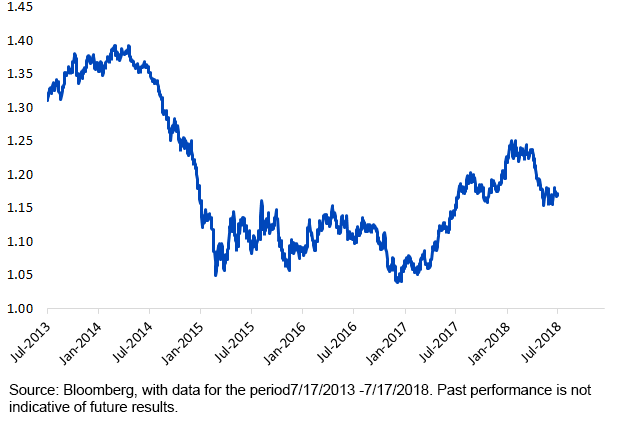Italian Economics: Watch Salvini



In April, the Italian public was so incensed by the country’s broken government budget, endemic graft and unaffordable inward migration that half of the general election vote went to two protest parties. On the left, the Five Star Movement topped all, with 32% support, while the right-wing League party took 18%. Since then, the League has gathered even more support. Its leader, Matteo Salvini, may now be the most powerful person in Italy.
Salvini’s Answer to the European Question
With a wave of migration from North Africa and the Middle East in recent years, Italy finds itself dealing with culture clashes and a scramble to find the money to house and feed the new arrivals.
But amid all the talk of the migrant crisis, what has gone largely unnoticed is that both Five Star and the League have some economic policies that are irrational at best, dangerous at worst. With the news cycle focused on cultural issues, we are wise to remember that Salvini, currently positioned as the champion of nativist Italy, has communist roots. His economic belief system has shifted with age, but this is no solace to EUR longs.
Key Planks
The coalition government’s common ground includes overturning the Fornero Law, which increased retirement ages and putting a universal basic income of €780 per month ($914) on the table. However, the coalition does interestingly entertain the idea of a flat tax. All of these together would conspire to blow out Italy’s 2.3% budget deficit-to-GDP ratio.
Positive Backdrop
Italy’s 1.4% GDP growth may be anemic, but it is above water, and high by Italian standards; the norm this century is +0.4%. The manufacturing purchasing managers’ index, at 53.3, has essentially been in nonstop expansion since the first quarter of 2015.1 Unemployment is down to a still-troubling 11.1%, but it was nearly 13% in 2014. Investors must ask: what odd fiscal and/or monetary policies will voters demand if conditions become recessionary?
Start with one such policy, which Brussels fears, that is haunting the bond market and EUR.
The Specter of a Parallel Currency
A “New Lira,” side-by-side with the euro. The state will not come out and say it at the moment, but that’s what the proposal for “mini-BOTs” will mean. If Five Star and the League do go down this path, mini-BOTs would be short maturity debt instruments that can be used to state obligations. On the other side of the ledger, owners of the mini-BOTs could use them to pay taxes. This risk has been haunting the bond market and the EU since since the idea entered the conversation in mid-May.
For This Privilege
Figure 1 highlights in blue the smattering of developed market bonds that yield more than U.S. Treasuries. Only long-dated Italian and Australian paper exceeds near-term U.S. government obligations.
Figure 1: Sovereign Yields (Highlighted Blue if > U.S. Two-Year Treasury)

December Looms
The stated aim of the European Central Bank (ECB) is to “keep prices stable, thereby supporting economic growth and job creation.” But in the last decade, what mattered is its implicit mandate: keep Europe together. But the ECB’s bond purchase program is set to expire in 5 months. The combination of fuzzier European economic data and the potential for Italian mini-BOTs could cause a “dovish” surprise by the ECB’s Mario Draghi, in which he vows to extend the bloc’s zero interest rate policy into the next decade. That could harm EUR bulls.
European Banks Not Yet Indicating Contagion
One way in which European systemic risks can be priced is via bank credit default swaps (CDS). Figure 2 shows current CDS levels along with the peak fear points of the last five years.
Figure 2: CDS Prices, Europe’s Systemically Important Bank Risk vs. Recent Peaks

UniCredit and Intesa Sanpaolo, the Italian banks, have CDS prices of 148 and 159, respectively, still less than half the June 2013 peaks. Both banks’ spreads are more than double their springtime levels. Spain’s BBVA and Banco Santander also witnessed spikes.
Risk Transmission Mechanism: The euro
An avoidable portfolio risk amid the Italian political saga is in euro-denominated equities that are not currency hedged. The euro has dropped more nearly 7% against the U.S. dollar since its nearby high on February 1, 2018 (figure 3).
Figure 3: USD vs. EUR

Hedging Euro Risk
It is far from certain how Italy’s relationship with Common Europe will work out. But allocating to European equities need not entail taking unnecessary risks. Direct exposure to EUR in this environment is unnerving. WisdomTree is known for currency hedging; now may be the time to think about the matter in global allocations.
1Source: Markit. Data as of May 2018.

Christopher Gannatti began at WisdomTree as a Research Analyst in December 2010, working directly with Jeremy Schwartz, CFA®, Director of Research. In January of 2014, he was promoted to Associate Director of Research where he was responsible to lead different groups of analysts and strategists within the broader Research team at WisdomTree. In February of 2018, Christopher was promoted to Head of Research, Europe, where he was based out of WisdomTree’s London office and was responsible for the full WisdomTree research effort within the European market, as well as supporting the UCITs platform globally. In November 2021, Christopher was promoted to Global Head of Research, now responsible for numerous communications on investment strategy globally, particularly in the thematic equity space. Christopher came to WisdomTree from Lord Abbett, where he worked for four and a half years as a Regional Consultant. He received his MBA in Quantitative Finance, Accounting, and Economics from NYU’s Stern School of Business in 2010, and he received his bachelor’s degree from Colgate University in Economics in 2006. Christopher is a holder of the Chartered Financial Analyst Designation.


